display VOLVO V60 2013 Owners Manual
[x] Cancel search | Manufacturer: VOLVO, Model Year: 2013, Model line: V60, Model: VOLVO V60 2013Pages: 422, PDF Size: 9.59 MB
Page 7 of 422
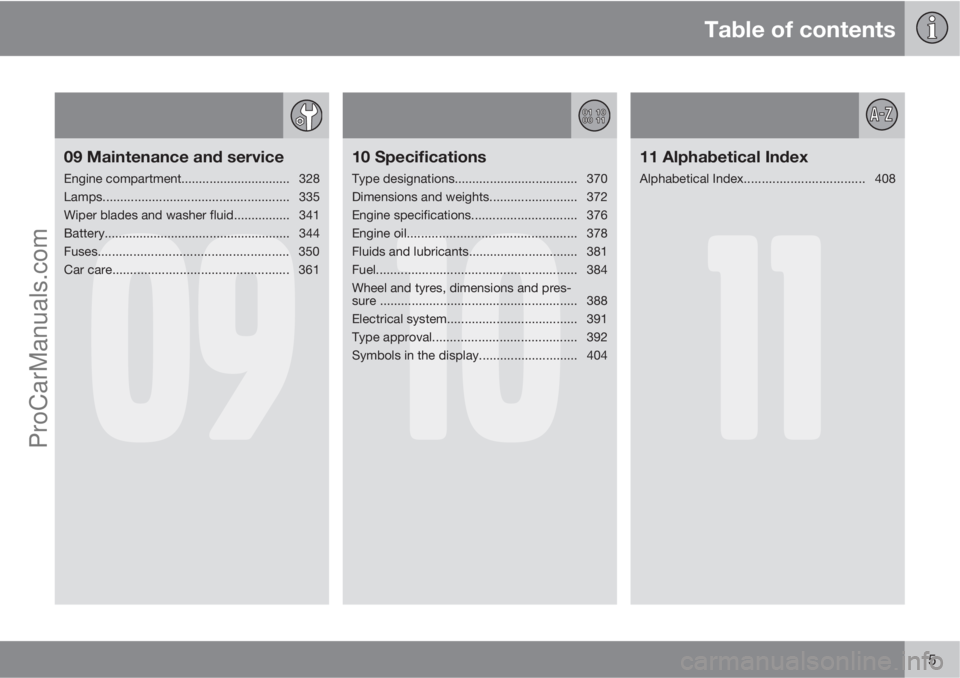
Table of contents
5
09
09 Maintenance and service
Engine compartment............................... 328
Lamps.....................................................335
Wiper blades and washer fluid................ 341
Battery..................................................... 344
Fuses...................................................... 350
Car care.................................................. 361
10
10 Specifications
Type designations................................... 370
Dimensions and weights......................... 372
Engine specifications.............................. 376
Engine oil................................................ 378
Fluids and lubricants............................... 381
Fuel.........................................................384
Wheel and tyres, dimensions and pres-
sure ........................................................ 388
Electrical system..................................... 391
Type approval......................................... 392
Symbols in the display............................404
11
11 Alphabetical Index
Alphabetical Index..................................408
ProCarManuals.com
Page 8 of 422
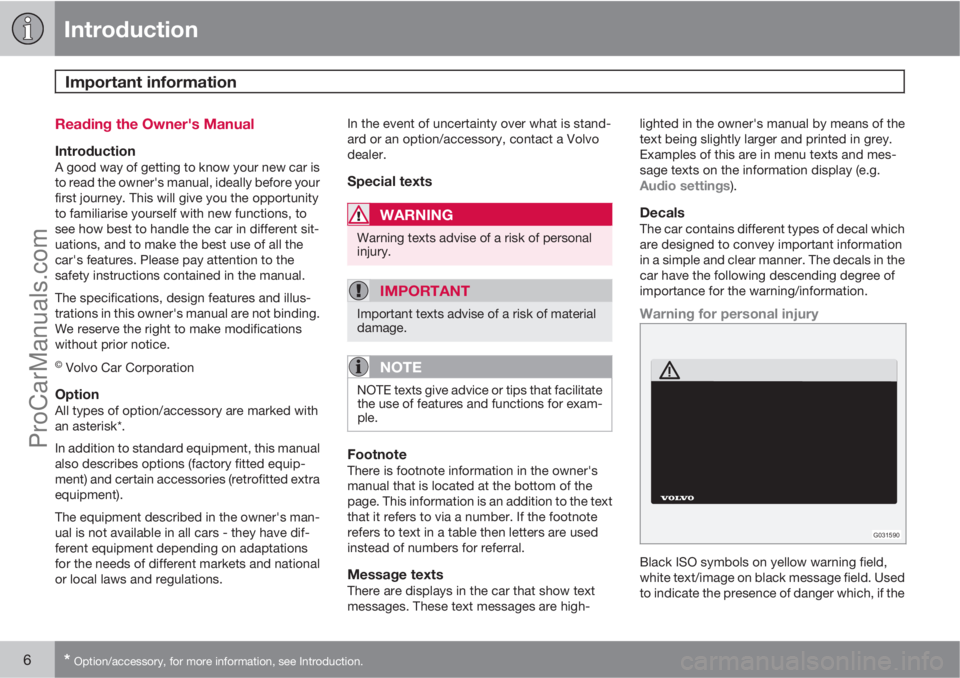
Introduction
Important information
6* Option/accessory, for more information, see Introduction.
Reading the Owner's Manual
IntroductionA good way of getting to know your new car is
to read the owner's manual, ideally before your
first journey. This will give you the opportunity
to familiarise yourself with new functions, to
see how best to handle the car in different sit-
uations, and to make the best use of all the
car's features. Please pay attention to the
safety instructions contained in the manual.
The specifications, design features and illus-
trations in this owner's manual are not binding.
We reserve the right to make modifications
without prior notice.
© Volvo Car Corporation
OptionAll types of option/accessory are marked with
an asterisk*.
In addition to standard equipment, this manual
also describes options (factory fitted equip-
ment) and certain accessories (retrofitted extra
equipment).
The equipment described in the owner's man-
ual is not available in all cars - they have dif-
ferent equipment depending on adaptations
for the needs of different markets and national
or local laws and regulations.In the event of uncertainty over what is stand-
ard or an option/accessory, contact a Volvo
dealer.
Special texts
WARNING
Warning texts advise of a risk of personal
injury.
IMPORTANT
Important texts advise of a risk of material
damage.
NOTE
NOTE texts give advice or tips that facilitate
the use of features and functions for exam-
ple.
FootnoteThere is footnote information in the owner's
manual that is located at the bottom of the
page. This information is an addition to the text
that it refers to via a number. If the footnote
refers to text in a table then letters are used
instead of numbers for referral.
Message textsThere are displays in the car that show text
messages. These text messages are high-lighted in the owner's manual by means of the
text being slightly larger and printed in grey.
Examples of this are in menu texts and mes-
sage texts on the information display (e.g.
Audio settings).
DecalsThe car contains different types of decal which
are designed to convey important information
in a simple and clear manner. The decals in the
car have the following descending degree of
importance for the warning/information.
Warning for personal injury
G031590
Black ISO symbols on yellow warning field,
white text/image on black message field. Used
to indicate the presence of danger which, if the
ProCarManuals.com
Page 20 of 422
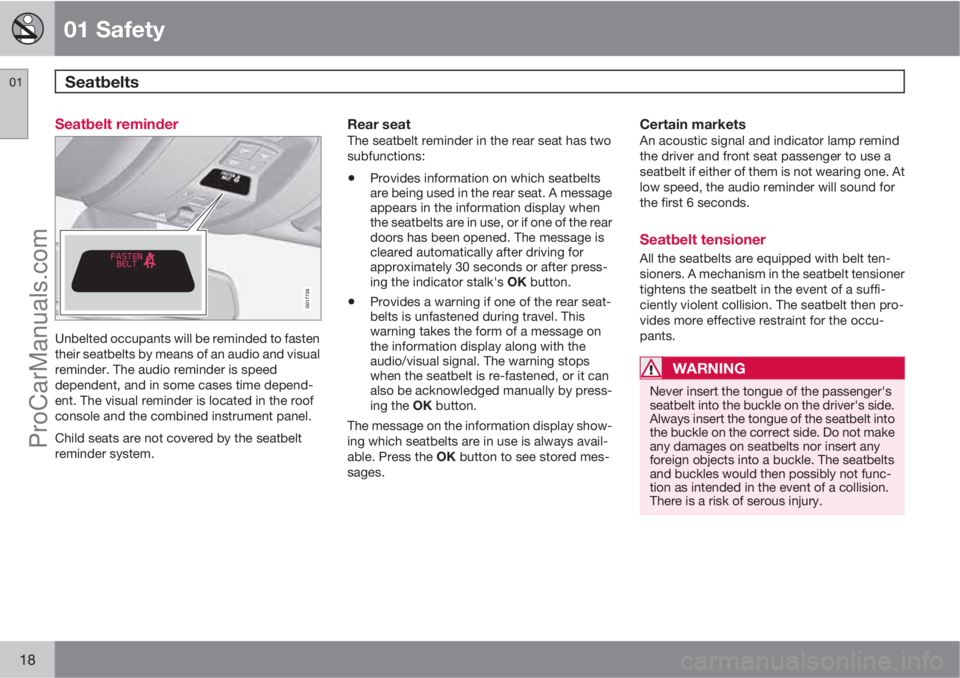
01 Safety
Seatbelts 01
18
Seatbelt reminder
G017726
Unbelted occupants will be reminded to fasten
their seatbelts by means of an audio and visual
reminder. The audio reminder is speed
dependent, and in some cases time depend-
ent. The visual reminder is located in the roof
console and the combined instrument panel.
Child seats are not covered by the seatbelt
reminder system.
Rear seatThe seatbelt reminder in the rear seat has two
subfunctions:
•Provides information on which seatbelts
are being used in the rear seat. A message
appears in the information display when
the seatbelts are in use, or if one of the rear
doors has been opened. The message is
cleared automatically after driving for
approximately 30 seconds or after press-
ing the indicator stalk's OK button.
•Provides a warning if one of the rear seat-
belts is unfastened during travel. This
warning takes the form of a message on
the information display along with the
audio/visual signal. The warning stops
when the seatbelt is re-fastened, or it can
also be acknowledged manually by press-
ing the OK button.
The message on the information display show-
ing which seatbelts are in use is always avail-
able. Press the OK button to see stored mes-
sages.
Certain marketsAn acoustic signal and indicator lamp remind
the driver and front seat passenger to use a
seatbelt if either of them is not wearing one. At
low speed, the audio reminder will sound for
the first 6 seconds.
Seatbelt tensioner
All the seatbelts are equipped with belt ten-
sioners. A mechanism in the seatbelt tensioner
tightens the seatbelt in the event of a suffi-
ciently violent collision. The seatbelt then pro-
vides more effective restraint for the occu-
pants.
WARNING
Never insert the tongue of the passenger's
seatbelt into the buckle on the driver's side.
Always insert the tongue of the seatbelt into
the buckle on the correct side. Do not make
any damages on seatbelts nor insert any
foreign objects into a buckle. The seatbelts
and buckles would then possibly not func-
tion as intended in the event of a collision.
There is a risk of serous injury.
ProCarManuals.com
Page 21 of 422
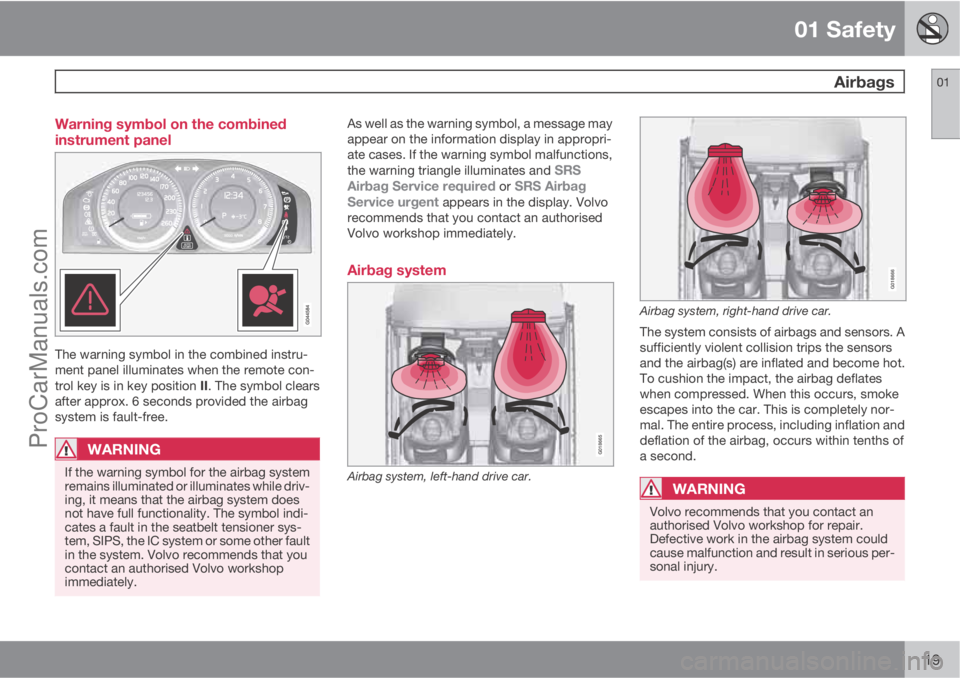
01 Safety
Airbags01
19 Warning symbol on the combined
instrument panel
The warning symbol in the combined instru-
ment panel illuminates when the remote con-
trol key is in key position II. The symbol clears
after approx. 6 seconds provided the airbag
system is fault-free.
WARNING
If the warning symbol for the airbag system
remains illuminated or illuminates while driv-
ing, it means that the airbag system does
not have full functionality. The symbol indi-
cates a fault in the seatbelt tensioner sys-
tem, SIPS, the IC system or some other fault
in the system. Volvo recommends that you
contact an authorised Volvo workshop
immediately.
As well as the warning symbol, a message may
appear on the information display in appropri-
ate cases. If the warning symbol malfunctions,
the warning triangle illuminates and
SRS
Airbag Service required or SRS Airbag
Service urgent appears in the display. Volvo
recommends that you contact an authorised
Volvo workshop immediately.
Airbag system
G018665
Airbag system, left-hand drive car.
G018666
Airbag system, right-hand drive car.
The system consists of airbags and sensors. A
sufficiently violent collision trips the sensors
and the airbag(s) are inflated and become hot.
To cushion the impact, the airbag deflates
when compressed. When this occurs, smoke
escapes into the car. This is completely nor-
mal. The entire process, including inflation and
deflation of the airbag, occurs within tenths of
a second.
WARNING
Volvo recommends that you contact an
authorised Volvo workshop for repair.
Defective work in the airbag system could
cause malfunction and result in serious per-
sonal injury.
ProCarManuals.com
Page 24 of 422
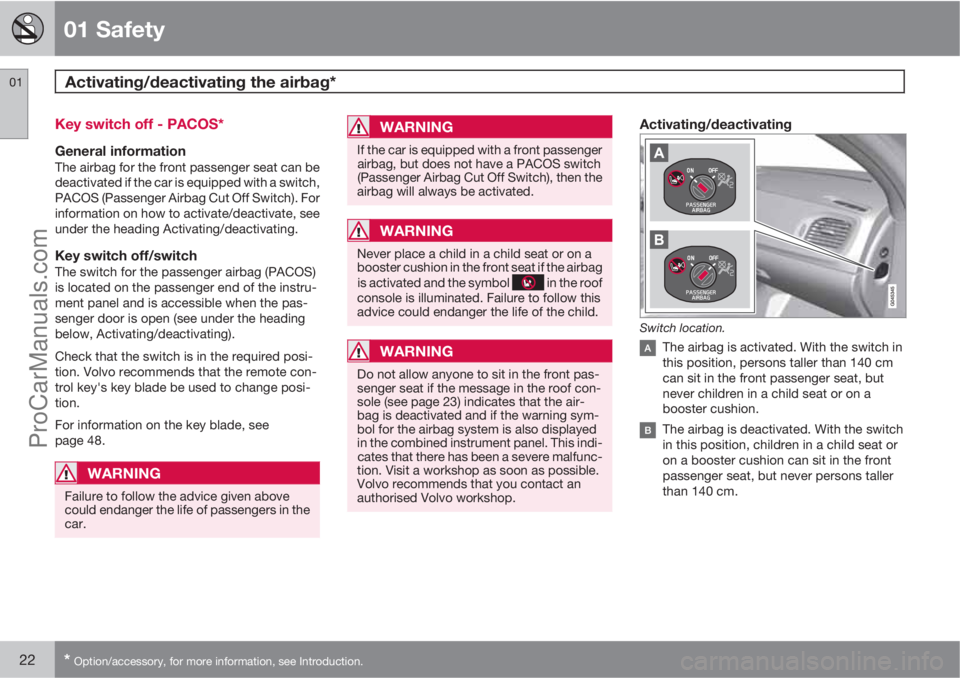
01 Safety
Activating/deactivating the airbag* 01
22* Option/accessory, for more information, see Introduction.
Key switch off - PACOS*
General informationThe airbag for the front passenger seat can be
deactivated if the car is equipped with a switch,
PACOS (Passenger Airbag Cut Off Switch). For
information on how to activate/deactivate, see
under the heading Activating/deactivating.
Key switch off/switchThe switch for the passenger airbag (PACOS)
is located on the passenger end of the instru-
ment panel and is accessible when the pas-
senger door is open (see under the heading
below, Activating/deactivating).
Check that the switch is in the required posi-
tion. Volvo recommends that the remote con-
trol key's key blade be used to change posi-
tion.
For information on the key blade, see
page 48.
WARNING
Failure to follow the advice given above
could endanger the life of passengers in the
car.
WARNING
If the car is equipped with a front passenger
airbag, but does not have a PACOS switch
(Passenger Airbag Cut Off Switch), then the
airbag will always be activated.
WARNING
Never place a child in a child seat or on a
booster cushion in the front seat if the airbag
is activated and the symbol
in the roof
console is illuminated. Failure to follow this
advice could endanger the life of the child.
WARNING
Do not allow anyone to sit in the front pas-
senger seat if the message in the roof con-
sole (see page 23) indicates that the air-
bag is deactivated and if the warning sym-
bol for the airbag system is also displayed
in the combined instrument panel. This indi-
cates that there has been a severe malfunc-
tion. Visit a workshop as soon as possible.
Volvo recommends that you contact an
authorised Volvo workshop.
Activating/deactivating
Switch location.
The airbag is activated. With the switch in
this position, persons taller than 140 cm
can sit in the front passenger seat, but
never children in a child seat or on a
booster cushion.
The airbag is deactivated. With the switch
in this position, children in a child seat or
on a booster cushion can sit in the front
passenger seat, but never persons taller
than 140 cm.
ProCarManuals.com
Page 25 of 422
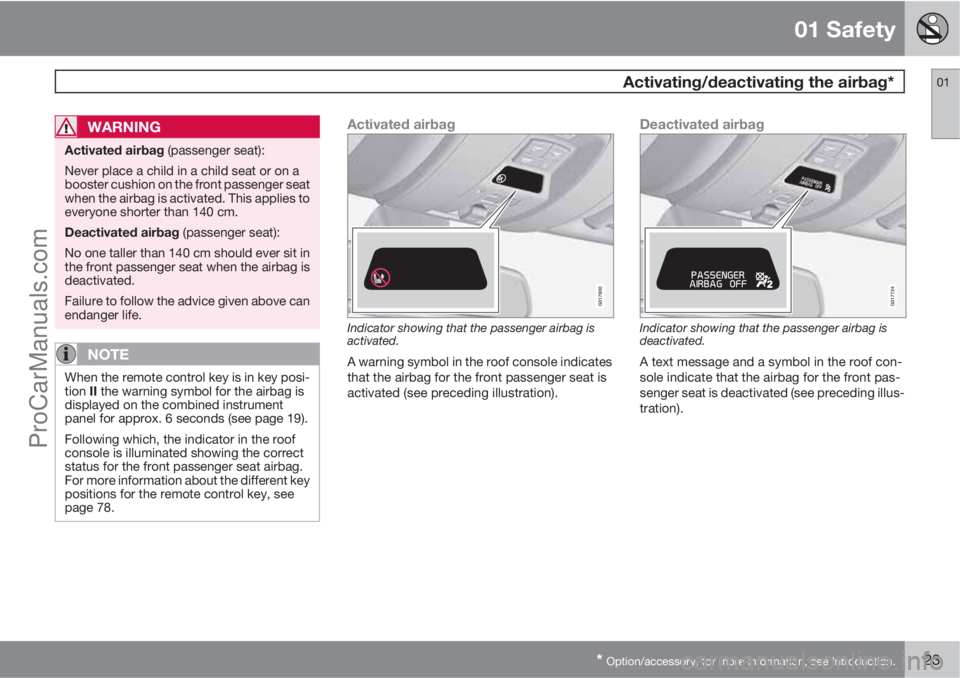
01 Safety
Activating/deactivating the airbag*01
* Option/accessory, for more information, see Introduction.23
WARNING
Activated airbag (passenger seat):
Never place a child in a child seat or on a
booster cushion on the front passenger seat
when the airbag is activated. This applies to
everyone shorter than 140 cm.
Deactivated airbag (passenger seat):
No one taller than 140 cm should ever sit in
the front passenger seat when the airbag is
deactivated.
Failure to follow the advice given above can
endanger life.
NOTE
When the remote control key is in key posi-
tion II the warning symbol for the airbag is
displayed on the combined instrument
panel for approx. 6 seconds (see page 19).
Following which, the indicator in the roof
console is illuminated showing the correct
status for the front passenger seat airbag.
For more information about the different key
positions for the remote control key, see
page 78.
Activated airbag
G017800
Indicator showing that the passenger airbag is
activated.
A warning symbol in the roof console indicates
that the airbag for the front passenger seat is
activated (see preceding illustration).
Deactivated airbag
2
2
G017724
Indicator showing that the passenger airbag is
deactivated.
A text message and a symbol in the roof con-
sole indicate that the airbag for the front pas-
senger seat is deactivated (see preceding illus-
tration).
ProCarManuals.com
Page 32 of 422
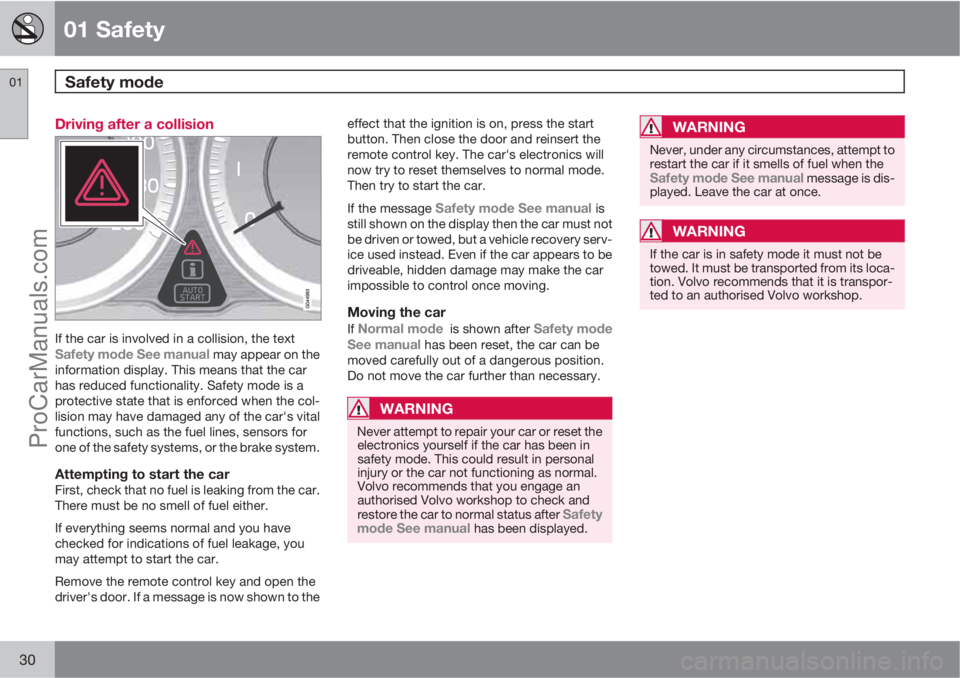
01 Safety
Safety mode 01
30
Driving after a collision
If the car is involved in a collision, the textSafety mode See manual may appear on the
information display. This means that the car
has reduced functionality. Safety mode is a
protective state that is enforced when the col-
lision may have damaged any of the car's vital
functions, such as the fuel lines, sensors for
one of the safety systems, or the brake system.
Attempting to start the carFirst, check that no fuel is leaking from the car.
There must be no smell of fuel either.
If everything seems normal and you have
checked for indications of fuel leakage, you
may attempt to start the car.
Remove the remote control key and open the
driver's door. If a message is now shown to theeffect that the ignition is on, press the start
button. Then close the door and reinsert the
remote control key. The car's electronics will
now try to reset themselves to normal mode.
Then try to start the car.
If the message
Safety mode See manual is
still shown on the display then the car must not
be driven or towed, but a vehicle recovery serv-
ice used instead. Even if the car appears to be
driveable, hidden damage may make the car
impossible to control once moving.
Moving the car
If Normal mode is shown after Safety mode
See manual has been reset, the car can be
moved carefully out of a dangerous position.
Do not move the car further than necessary.
WARNING
Never attempt to repair your car or reset the
electronics yourself if the car has been in
safety mode. This could result in personal
injury or the car not functioning as normal.
Volvo recommends that you engage an
authorised Volvo workshop to check and
restore the car to normal status after
Safety
mode See manual has been displayed.
WARNING
Never, under any circumstances, attempt to
restart the car if it smells of fuel when the
Safety mode See manual message is dis-
played. Leave the car at once.
WARNING
If the car is in safety mode it must not be
towed. It must be transported from its loca-
tion. Volvo recommends that it is transpor-
ted to an authorised Volvo workshop.
ProCarManuals.com
Page 47 of 422
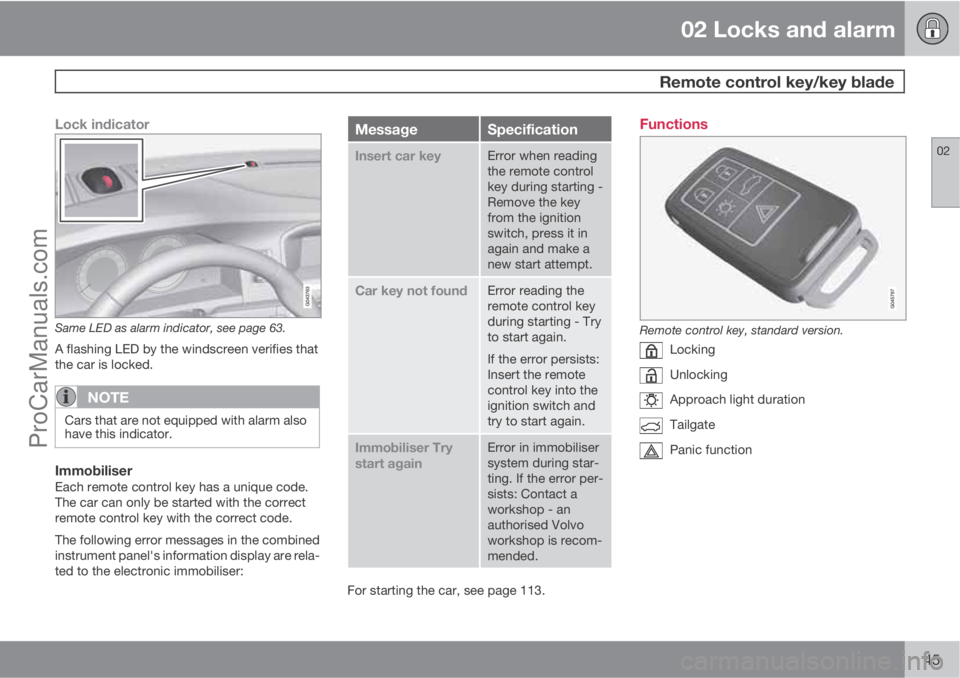
02 Locks and alarm
Remote control key/key blade
02
45
Lock indicator
Same LED as alarm indicator, see page 63.
A flashing LED by the windscreen verifies that
the car is locked.
NOTE
Cars that are not equipped with alarm also
have this indicator.
ImmobiliserEach remote control key has a unique code.
The car can only be started with the correct
remote control key with the correct code.
The following error messages in the combined
instrument panel's information display are rela-
ted to the electronic immobiliser:
MessageSpecification
Insert car keyError when reading
the remote control
key during starting -
Remove the key
from the ignition
switch, press it in
again and make a
new start attempt.
Car key not foundError reading the
remote control key
during starting - Try
to start again.
If the error persists:
Insert the remote
control key into the
ignition switch and
try to start again.
Immobiliser Try
start againError in immobiliser
system during star-
ting. If the error per-
sists: Contact a
workshop - an
authorised Volvo
workshop is recom-
mended.
For starting the car, see page 113.
Functions
Remote control key, standard version.
Locking
Unlocking
Approach light duration
Tailgate
Panic function
ProCarManuals.com
Page 48 of 422
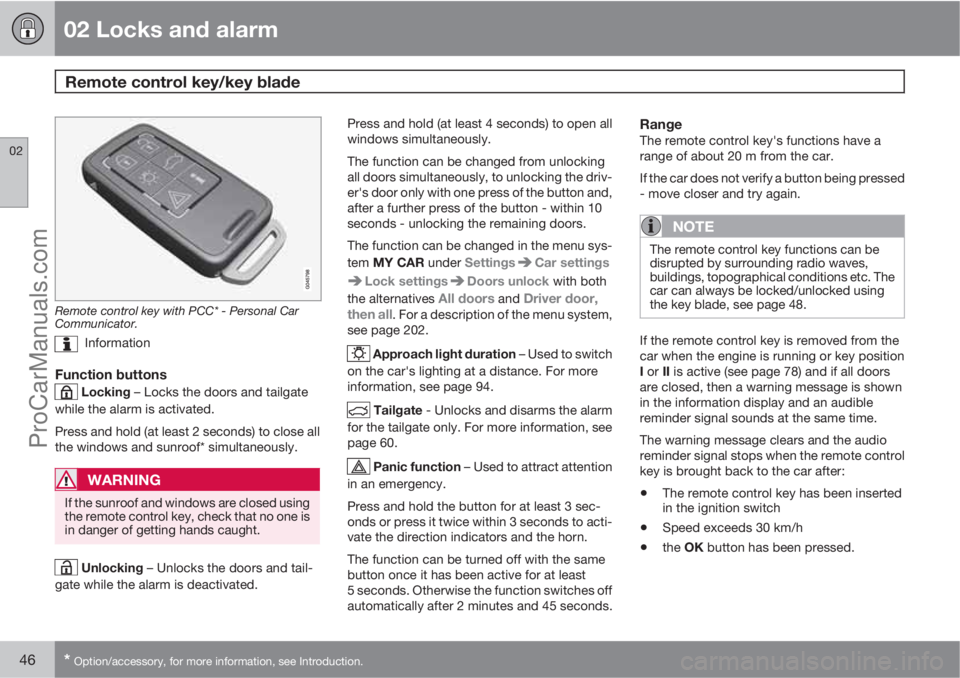
02 Locks and alarm
Remote control key/key blade
02
46* Option/accessory, for more information, see Introduction.
Remote control key with PCC* - Personal Car
Communicator.
Information
Function buttons
Locking – Locks the doors and tailgate
while the alarm is activated.
Press and hold (at least 2 seconds) to close all
the windows and sunroof* simultaneously.
WARNING
If the sunroof and windows are closed using
the remote control key, check that no one is
in danger of getting hands caught.
Unlocking – Unlocks the doors and tail-
gate while the alarm is deactivated.Press and hold (at least 4 seconds) to open all
windows simultaneously.
The function can be changed from unlocking
all doors simultaneously, to unlocking the driv-
er's door only with one press of the button and,
after a further press of the button - within 10
seconds - unlocking the remaining doors.
The function can be changed in the menu sys-
tem MY CAR under Settings
Car settings
Lock settingsDoors unlock with both
the alternatives
All doors and Driver door,
then all. For a description of the menu system,
see page 202.
Approach light duration – Used to switch
on the car's lighting at a distance. For more
information, see page 94.
Tailgate - Unlocks and disarms the alarm
for the tailgate only. For more information, see
page 60.
Panic function – Used to attract attention
in an emergency.
Press and hold the button for at least 3 sec-
onds or press it twice within 3 seconds to acti-
vate the direction indicators and the horn.
The function can be turned off with the same
button once it has been active for at least
5 seconds. Otherwise the function switches off
automatically after 2 minutes and 45 seconds.
RangeThe remote control key's functions have a
range of about 20 m from the car.
If the car does not verify a button being pressed
- move closer and try again.
NOTE
The remote control key functions can be
disrupted by surrounding radio waves,
buildings, topographical conditions etc. The
car can always be locked/unlocked using
the key blade, see page 48.
If the remote control key is removed from the
car when the engine is running or key position
I or II is active (see page 78) and if all doors
are closed, then a warning message is shown
in the information display and an audible
reminder signal sounds at the same time.
The warning message clears and the audio
reminder signal stops when the remote control
key is brought back to the car after:
•The remote control key has been inserted
in the ignition switch
•Speed exceeds 30 km/h
•the OK button has been pressed.
ProCarManuals.com
Page 49 of 422
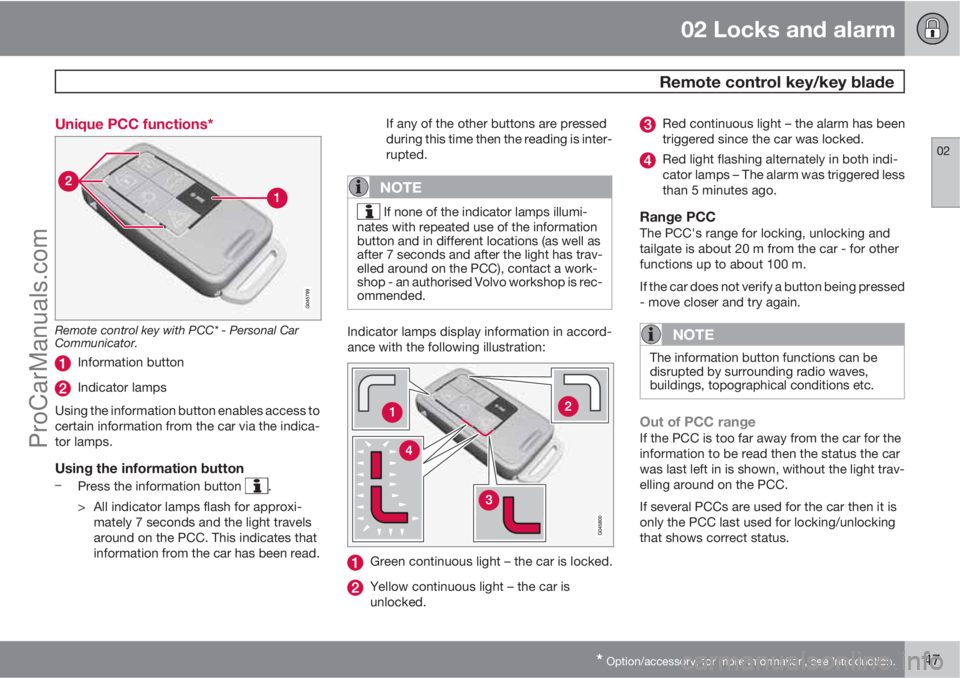
02 Locks and alarm
Remote control key/key blade
02
* Option/accessory, for more information, see Introduction.47 Unique PCC functions*
Remote control key with PCC* - Personal Car
Communicator.
Information button
Indicator lamps
Using the information button enables access to
certain information from the car via the indica-
tor lamps.
Using the information button–
Press the information button .
> All indicator lamps flash for approxi-
mately 7 seconds and the light travels
around on the PCC. This indicates that
information from the car has been read.If any of the other buttons are pressed
during this time then the reading is inter-
rupted.
NOTE
If none of the indicator lamps illumi-
nates with repeated use of the information
button and in different locations (as well as
after 7 seconds and after the light has trav-
elled around on the PCC), contact a work-
shop - an authorised Volvo workshop is rec-
ommended.
Indicator lamps display information in accord-
ance with the following illustration:
Green continuous light – the car is locked.
Yellow continuous light – the car is
unlocked.
Red continuous light – the alarm has been
triggered since the car was locked.
Red light flashing alternately in both indi-
cator lamps – The alarm was triggered less
than 5 minutes ago.
Range PCCThe PCC's range for locking, unlocking and
tailgate is about 20 m from the car - for other
functions up to about 100 m.
If the car does not verify a button being pressed
- move closer and try again.
NOTE
The information button functions can be
disrupted by surrounding radio waves,
buildings, topographical conditions etc.
Out of PCC rangeIf the PCC is too far away from the car for the
information to be read then the status the car
was last left in is shown, without the light trav-
elling around on the PCC.
If several PCCs are used for the car then it is
only the PCC last used for locking/unlocking
that shows correct status.
ProCarManuals.com